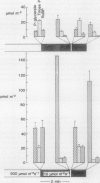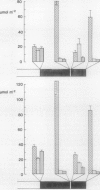Abstract
In the shade plant Alocasia macrorrhiza grown in low light, photosynthetic CO2 assimilation during a 5 second lightfleck plus postillumination CO2 assimilation can allow up to 60% more photosynthesis than that which occurs during 5 seconds of steady state light of the same intensity (RL Chazdon, RW Pearcy 1986 Oecologia. 69: 524-531). Metabolites of photosynthesis were measured to determine if the pool of ribulose 1,5-bisphosphate (RuBP) could account for all of the postillumination CO2 assimilation following a lightfleck in Alocasia. It was found that the pool of triose-P was much larger than that of RuBP and could account for five times more postillumination CO2 assimilation than could RuBP. The same trend was seen in the sun plant Phaseolus vulgaris when it was grown in the shade. In contrast, sun-grown Alocasia and Phasiolus did not have a large pool of triose-P relative to RuBP following a lightfleck. In sun plants, carbon may rapidly be converted to RuBP in the light whereas in shade plants there may be a restriction in the path between the triose-P and RuBP pools. It is hypothesized that in shade plants the buildup of triose-P rather than RuBP during the lightfleck prevents inhibition of electron transport which may otherwise occur because of competition for ATP between the two kinases of the photosynthetic carbon reduction cycle. Utilization of the triose-P for postillumination CO2 fixation would require the capacity for significant postillumination ATP synthesis. The extensive grana stacking and large intrathylakoid space which accompanies the high level of chlorophyll in low-light-grown Alocasia could be an important contributing factor to postillumination ATP formation.
Full text
PDF





Images in this article
Selected References
These references are in PubMed. This may not be the complete list of references from this article.
- Arnon D. I. COPPER ENZYMES IN ISOLATED CHLOROPLASTS. POLYPHENOLOXIDASE IN BETA VULGARIS. Plant Physiol. 1949 Jan;24(1):1–15. doi: 10.1104/pp.24.1.1. [DOI] [PMC free article] [PubMed] [Google Scholar]
- Laisk A., Kiirats O., Oja V. Assimilatory Power (Postillumination CO(2) Uptake) in Leaves: Measurement, Environmental Dependencies, and Kinetic Properties. Plant Physiol. 1984 Nov;76(3):723–729. doi: 10.1104/pp.76.3.723. [DOI] [PMC free article] [PubMed] [Google Scholar]
- Seemann J. R., Sharkey T. D. Salinity and Nitrogen Effects on Photosynthesis, Ribulose-1,5-Bisphosphate Carboxylase and Metabolite Pool Sizes in Phaseolus vulgaris L. Plant Physiol. 1986 Oct;82(2):555–560. doi: 10.1104/pp.82.2.555. [DOI] [PMC free article] [PubMed] [Google Scholar]
- Sharkey T. D., Seemann J. R., Berry J. A. Regulation of Ribulose-1,5-Bisphosphate Carboxylase Activity in Response to Changing Partial Pressure of O(2) and Light in Phaseolus vulgaris. Plant Physiol. 1986 Jul;81(3):788–791. doi: 10.1104/pp.81.3.788. [DOI] [PMC free article] [PubMed] [Google Scholar]
- Slabas A. R., Walker D. A. Transient inhibition by ribose 5-phosphate of photosynthetic O2 evolution in a reconstituted chloroplast system. Biochim Biophys Acta. 1976 Apr 9;430(1):154–164. doi: 10.1016/0005-2728(76)90231-0. [DOI] [PubMed] [Google Scholar]
- Stitt M. Limitation of Photosynthesis by Carbon Metabolism : I. Evidence for Excess Electron Transport Capacity in Leaves Carrying Out Photosynthesis in Saturating Light and CO(2). Plant Physiol. 1986 Aug;81(4):1115–1122. doi: 10.1104/pp.81.4.1115. [DOI] [PMC free article] [PubMed] [Google Scholar]




